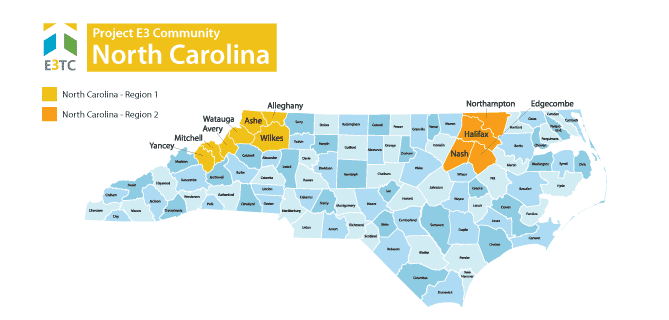North Carolina was chosen as a targeted community through the Vocational Rehabilitation Technical Assistance Center: Targeted Communities (VR-TAC-TC) or Project E3. Project E3 partnered with State VR Agencies and local community partners to improve outreach and employment-related services to underserved people with disabilities in this community.
 North Carolina boasts scenic beauty, a moderate climate, a culture rich in history and the arts, and world-class sports and recreational opportunities. With 300 miles of Atlantic coastline and the highest mountain peaks east of the Rockies, it is the 6th most-visited state in the nation.
North Carolina boasts scenic beauty, a moderate climate, a culture rich in history and the arts, and world-class sports and recreational opportunities. With 300 miles of Atlantic coastline and the highest mountain peaks east of the Rockies, it is the 6th most-visited state in the nation.
North Carolina has the 9th largest economy in the United States. It is the United States’ top producer of sweet potatoes and the 2nd largest producer of Christmas trees.
There has been a clear division in the economic growth of North Carolina's urban and rural areas since 2000. Urban areas show steady job growth, low unemployment, and rising wages, while many rural counties have experienced job loss, rising levels of poverty, and population loss as their manufacturing base has declined.
Predicted employment growth areas include health and medical services, professional services, wholesale/retail trade, and construction-related industries. Construction is projected to be one of the fastest growing industries in the state, and healthcare support occupations and healthcare practitioners are projected to be the two fastest growing occupational groups.
Targeted Communities
The state-federal vocational rehabilitation system in North Carolina faced many challenges as it strove to serve people with significant disabilities and promote competitive integrated employment. Project E3 provided intensive technical assistance to two regions of the state:

Key Information:
Participation in Snap
Statewide average = 14.6%
Poverty Rate
Statewide average = 17.2%
Unemployment
Statewide average = 4.3%
Targeted Populations
These populations were characterized as:
Primary Challenges for Targeted Populations
Some of the challenges of this population in North Carolina included:
Key Strategies to Address Barriers
Following are some of the key strategies developed and implemented to address the targeted populations' challenges and barriers to employment.
Community Based Participatory Research (CBPR): To understand a community’s issues and concerns, one needs data and information both supplied by common data sources and interpreted by the community to better understand their issues and possible solutions to those issues. CBPR’s methodology is predicated on deep and extensive community involvement in the identification of issues and concerns and in the resolution of those issues and concerns.
- North Carolina Project E3: Poverty, Disability, and CBPR
Trauma Informed Care: North Carolina identified this as a needed strategy for adding expertise to their counseling approaches. After receiving training, NC discussed ways to apply in their daily work (uses of ACES as an example) as well as sustain TIC going forward (e.g., part of new counselor training package and a checklist).
Financial Literacy Training: After receiving the “Your Money, Your Goals” training staff thought that the budgeting worksheets, SSI Benefits Estimator and ABLE accounts would be most beneficial. Materials were shared with local partners to spread the work about financial empowerment. Staff intended to use parts of the training in their daily work.
Motivational Interviewing: Provided introductory information about MI and found it improved the Client Counselor interactions and addressed client concerns. Considered providing more in-depth training to further embed MI principles in daily work.
- Motivational Interviewing Change Questionnaire
- Presentation: Motivational Interviewing
- Presentation Slides: Motivational Interviewing
Self-Employment: North Carolina garnered community support and resources with day long sessions “Resources For Entrepreneurs With Disabilities” in Boone and Rocky Mount. Sessions brought together bankers, community development corporations, Chambers of Commerce, etc. to describe their services and meet VR staff.
- Agenda - Entrepreneurial Resources Event - Boone
- Agenda - Entrepreneurial Resources Event - Rocky Mount
Job Exploration Counseling: Innovative Strategies for Job Placement – 20 for 20 in 2020 – North Carolina found innovative strategies for job placement in a presentation by Ashley Cross at the 2019 Leadership Academy. In addition to training provided by Ms. Cross, North Carolina tested and expanded a creative strategy “20 for 20 in 2020”. This strategy had counselors pick 20 cases from their current caseload that they would focus extra attention to gain employment in 2020.
North Carolina Overview PowerPoint Presentation
Project Outcomes
Project E3 provided North Carolina’s state Vocational Rehabilitation agencies and their partners with the skills and competencies needed to effectively and efficiently address barriers to competitive integrated employment and community integration encountered by persons with disabilities in these regions.
Our specific goals for this project were to:
We will leverage promising practices, knowledge, and experience gained from this project to expand employment opportunities for individuals with disabilities from underserved and economically disadvantaged populations throughout North Carolina and across the United States.
Continuation and Sustainability Plan
Tools and Resources
North Carolina Project E3: Poverty, Disability, and CBPR
Financial Literacy Training
Job Exploration Counseling
Motivational Interviewing
- Motivational Interviewing Change Questionnaire
- Presentation: Motivational Interviewing
- Presentation Slides: Motivational Interviewing
Self-Employment
More Information
For further information about these community activities contact:

Kyle Walker, MRC, CRC, CPM
Executive Director
Stout Vocational Rehabilitation Institute (SVRI)
walkerky@uwstout.edu


